From 2030, sales of new petrol and diesel cars in the UK will be banned. It’s a huge, game-changing moment that’s less than a decade away, so it’s no surprise that manufacturers are already turning to EVs in earnest.
From being a relative novelty to present nearly everywhere, electric cars are fast creating a revolution. So to make sure you don’t get left behind, we’ve compiled a list of all the EVs that are currently on sale in the UK.
We’ve not included the button number, flight-of-fancy hypercars but instead concentrated on the machines that we’ve driven at Autocar and that you could walk into a dealership today and test drive before putting down your cash (or in Volvo’s case clicking on ‘pay now’ in its virtual online store) before driving away.
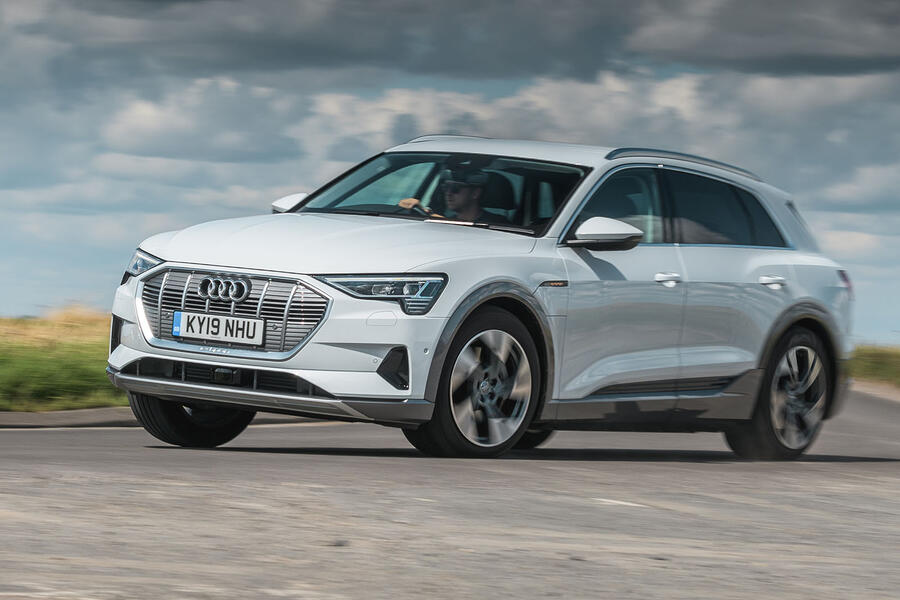
It’s probably no surprise that Audi’s first foray into the world of EVs had a very SUV flavour. Available in standard or rakish Sportback guise, the E-tron was deliberately designed to look as ‘normal’ as possible, so as not to put off buyers nervous about its high-tech underpinnings - although its door 'mirrors' that beam pictures to screens in the cabin are fairly futuristic. Comfort is the order of the day, with soft suspension and excellent refinement. All variants feature twin motors and four-wheel drive, while the larger-battery 55 claims up to 252 miles of range. The tri-motor S packs 496bhp, a 0-62mph time of 4.5sec and greater agility.
Sharing its underpinnings with the Porsche Taycan, the E-tron GT is in many respects a better all-round bet than its cousin. Sleek four-door coupé styling helps it stand out, while on the move it effortlessly blends blistering pace and back-road agility with long-distance quietness and comfort for impeccable grand touring credentials. The 637bhp RS version steals all the headlines for raw performance statistics, but with up to 523bhp available in brief spurts of overboost, the standard E-tron GT is no slouch, claiming a 4.1sec 0-62mph time and a longer (298-mile) range. Better still, 800V electrical architecture means an 80% can be achieved in as little as half an hour.
Audi’s entry-level EV is arguably its least convincing battery-powered offering. Based on the same MEB platform as the Skoda Enyaq iV and Volkswagen ID 4, it delivers arguably the same driving experience and range (up to 314 miles in the standard car and and 320 miles in the slipperier Sportback), yet charges you more for the privilege. Only the second Audi (after the R8 RWS) to offer rear-wheel drive, the Q4 is also available in twin-motor Quattro guise. Both are capable and composed to drive, but neither are inspiring, while the spacious interior feels no more special than that in the Skoda or Volkswagen. Still, the eye-catching Sportback version adds visual appeal, plus any Q4 can rapid charge at either 100kW or 125kW.
It’s hard to believe the innovative and quirky i3 has been around for the best part of a decade now. Designed from the ground up to be battery-powered, the tall and narrow compact hatchback still looks and feels like nothing else on the road. It features a light and strong carbon-reinforced plastic structure, suicide doors at the rear plus a minimalist interior packed with sustainable materials - although it seats only four and its boot is cramped. Despite skinny tyres, it's good to drive, particularly the more powerful i3s, but its age is starting to show through its maximum range of 190 miles and 50kW rapid-charging limit.
On paper, the i4 is essentially an electric version of the new 4 Series Gran Coupé, but there’s more to it than that. It has been heavily re-engineered to take the 80.7kWh lithium ion battery and either one (rear-drive) or two (four-wheel drive) motors, while inside it gets bespoke digital instruments and infotainment set in a large curved screen set on top of the dashboard. Near 50:50 weight distribution front to rear means engaging and agile handling, while a slippery 0.24Cd drag figure helps the entry-level eDrive40 Sport deliver a 365-mile range. The 536bhp M50 will crack 62mph in just 3.3sec and is BMW's first ever M-badged EV. Crucially, every i4 is capable of 200kW rapid-charging, which can add 100 miles of range in just 10 minutes.
With the all-new version of BMW's entry-level X1 comes an electric version for the first time - the iX1. Apart from the now trademark blue trim flourishs that highlight every electrified BMW, the iX1 looks more or less identical to its ICE siblings. Under the skin it packs a pair of electric motors that deliver a combined 308bhp, while the 64.7kWh battery promises a range of 272 miles, which is good but not exceptional. You can say the same about the driving experience. There's nothing wrong with the poised and planted BMW, it just lacks the driver engagement you'd expect from the brand. Still, it's refined and reasonably comfortable, while the interior is roomy and feels a cut above the competition in terms of design and quality.
Like the i4, the iX3 uses existing ICE architecture, in this case the X3. In fact, apart from a flush-fitting front grille and some natty blue trim inserts, it's largely the same as its fossil fuel-fed cousin. Curiously, it’s rear-drive-only, the 282bhp motor driving the back axle via a single-speed transmission. Still, it’s as good to drive as the ICE X3s, while the typically low noise levels and adaptive dampers make it comfy. The EV drivetrain robs 40 litres of boot space, but at 510 litres, it's still roomy enough and bigger than that of X3 PHEVs. There’s just the one battery available, but the 74kWh lithium ion pack can be rapid-charged to 80% in just half an hour and delivers a claimed range of 285 miles.
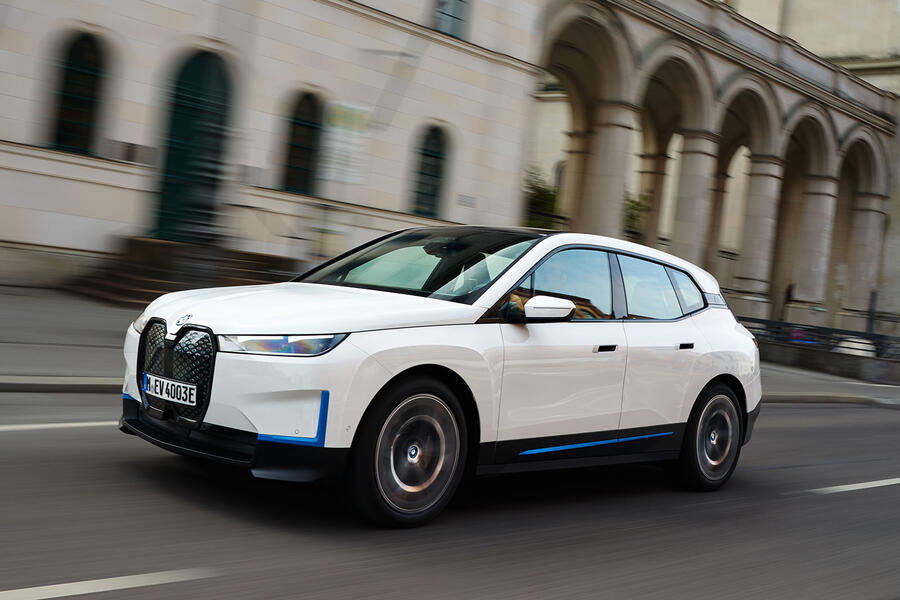
Few recent arrivals have stirred as much controversy as the iX, BMW’s flagship EV. Beauty has always been in the eye of the beholder, but surely even the most ardent BMW fan will struggle to put forward any praise for the slab-sided and awkwardly proportioned iX. Loosely based on the brand’s CLAR scalable architecture, it mixes the i3’s CFRP with aluminium, while the battery (a large 100kWh on the range-topping 500bhp xDrive50) is mounted low in the floor. Motors front and rear deliver four-wheel drive, while versions with that big pack claim an impressive 380 miles between charges. Air suspension means comfort is the order of the day, plus the interior is vast and lavishly finished – and at least you can’t see the exterior when you’re sitting in it.
It looks a little like a Portaloo on wheels, but the quirky Ami is packed with novel engineering and design that harks back to Citroën's innovative heyday. Technically a quadricycle, this teeny-tiny EV (it’s just 2.41 metres long) has been designed as a low-cost urban runaround. Its simple composite front and rear panels are interchangeable, as are its two doors, while its two-seat interior is masterclass in minimalism. Power comes from a 5.5kWh battery and the motor makes just 8bhp, meaning a range of just 43 miles and top speed of 28mph – both of which are perfect for inner-city excursions. Despite its left-hand drive layout the Ami has attracted plenty of interest from UK buyers, with Citroen recently relenting and offering the car on this shores for £7695, making it Britain’s cheapest new car.
Mixing rakish looks with a smattering of SUV styling cues, the ë-C4 is quite a bold and interesting looking family hatchback, standing out more than most. It's based on the standard C4, ditching that car’s ICE power for a 134bhp electric motor and 50kW battery that delivers a claimed 217 miles, and it has 100kW rapid-charging potential. It’s an easy car to get along with, if not one that’s as exciting to drive as it looks. Soft suspension makes it comfortable and easy-going but also one that won’t thank you for hustling it through corners. That motor also means performance is brisk rather than quick, with a 0-62mph dash of 9.0sec. Still, like the standard C4, its interior is roomy and it's boldly styled as the outside, plus there’s loads of standard kit.
ë-Berlingo
Like its Peugeot Rifter and Vauxhall Combo Life cousins, the Berlingo is now available with battery power only. Under the square-rigged by eminently sensible body is a 134bhp motor and 50kWh lithium ion cells, which combine to deliver adequate performance (think 1.2-litre turbo petrol but smoother and quieter) and a slightly disappointing 170 miles range - although 100kW rapid-charging is available. The rest of the car is the same, which means it’s packed with all the features that make it such a great family hauler, including the sliding rear doors, cavernous cabin and optional Modutop that combines panoramic roof and 92 litres of aircraft-style overhead storage. It’s also supremely relaxing on the move, thanks to a supple ride and high-set driving position.
ë-Spacetourer
The much larger e-Spacetourer is genetically identical to the Vauxhall Vivaro-e Life and Peugeot e-Traveller. Available with either eight or nine seats, this large MPV is really only for the biggest families or private hire taxi firms. It’s car-like to drive and its 134bhp electric motor makes it reasonably spritely, thanks to the relatively short gearing of its single-speed transmission, although top speed is only a whisker over 80mph. However, although Citroën claims the spacious interior is designed for long-distance comfort, you’re unlikely to spend much time in there, thanks to the 50kWh battery’s short 143 mile range.
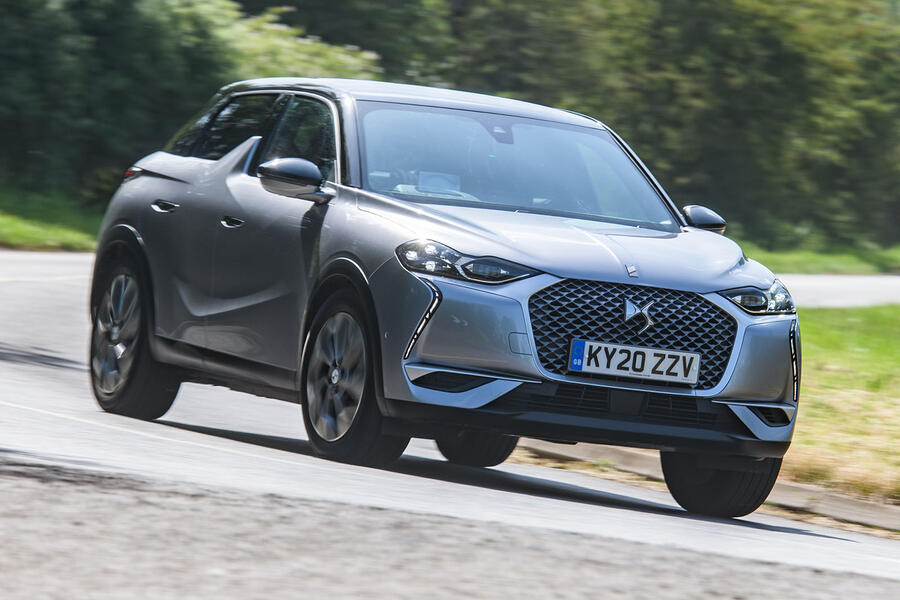
For its first foray into the EV world, DS has unsurprisingly taken aim at the profitable compact crossover class. Using the same CMP 1 platform as the Citroën ë-C4 and Peugeot e-2008, the strikingly styled (and lengthily named) 3 Crossback E-Tense also uses the same 134bhp electric motor and 50kWh battery, which delivers a range of up to 206 miles. On the move, the emphasis is on comfort, although the soft ride can get crashy, while the lifeless steering discourages press-on motoring. Still, the distinctively designed interior looks good and is well equipped, even if its premium aspirations don’t live up to a price that’s the wrong side of £30,000.
Reinventing its cute city car as an EV was a bold move for Fiat, but the end result proved it was a gamble worth taking. Fractionally bigger than the ICE 500, the new 500 EV retains well-resolved retro lines, while its interior quality and technology have taken huge leaps forward. Entry-level models get a 92bhp motor with a 24kWh battery, and on pricier versions these figures jump to 117bhp and 42kWh, increasing range from 124 to 199 miles. The 500 isn't as fun to drive as the Mini Electric, but it feels like a more grown-up package and has a more useful range.
Ford arrived a little late to the EV party, but with the Mustang Mach-E, it certainly made an entrance. Taking the name of the Blue Oval’s iconic muscle car ruffled a few feathers, but there’s no doubting that the Mustang Mach-E does justice to it, even if it is an SUV. There’s a choice of rear- and four-wheel drive models and a 68kWh or 88kWh battery, the latter giving up to 379 miles of range and the availability of 150kW rapid-charging. The flagship GT delivers 480bhp, but all Mustang Mach-Es are surprisingly satisfying to drive, with a nicely judged ride-and-handling balance. Top versions are expensive, but at around £41,000, the entry-level model makes a compelling case for itself.
Genesis
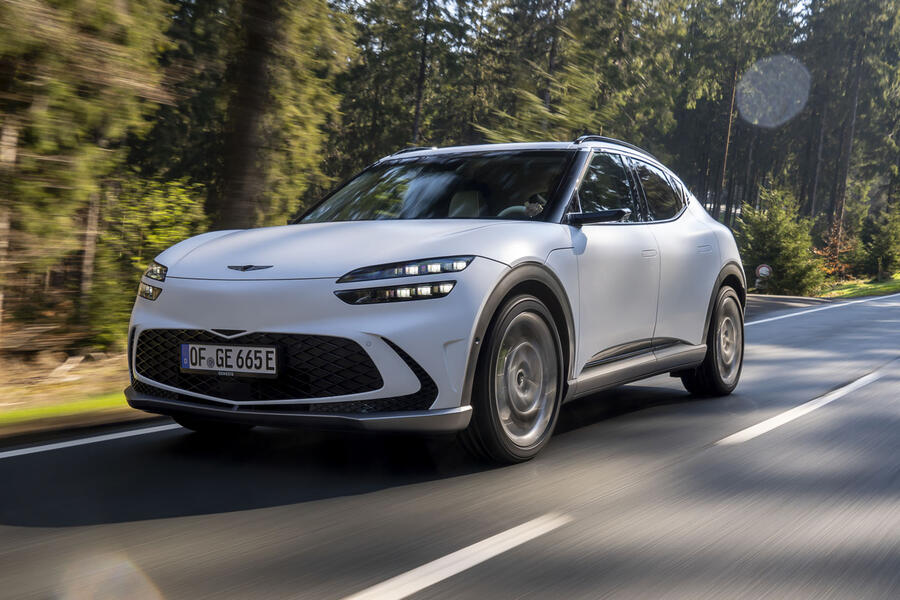
GV60We all scratched our heads last year when the Genesis brand made its UK debut with not even a hint of electrification in its line-up. The Hyuandi luxury sub-brand had big ambitions, but without so much as a mild-hybrid to its name, it had its work cut out to convince well-heeled buyers its big saloons and SUVs were worth a punt. However, that’s all changed, and this year the Korean firm has started an EV offensive, starting with this, the GV60. Essentially using the same 800 volt-equipped E-GMP platform as the Hyundai Ioniq 5 and Kia EV6, it serves-up a more luxurious vibe, with a decent dollop of style, speed and driver satisfaction. There’s a choice of single or twin motor layouts, with the latter serving up to 482bhp and getting a dedicated ‘Drift Mode’. Go for a more sensible rear-wheel drive model and the 73kWh battery (standard on all versions) will carry you a claimed 321 miles between charges.
The latest addition to the Genesis brand's all-electric line-up is a battery-powered version of its GV70 SUV. Like the other EVs in the Korean firm's line-up it uses 800V architecture that allows ultra rapid charging, with the 77.4kWh battery capable of being charged to 80 percent in 18 minutes using a 350kW charger. There's a twin motor four-wheel drive set-up, while a Boost function allows you access to 483bhp in 10 second bursts, yet the range is a respectable 283 miles. Accurate steering, decent grip and taut body control mean the GV70 can be hustled surprisingly hard, but it's more at home cruising when you can revel in its cushioned ride, low noise levels and exquisitely finished interior.
G80While the Genesis GV60 has been designed from the ground-up as an EV, the more expensive Electrified G80 is an adaptation of the brand’s flagship saloon model. A neat packaging job means you get two motors (for a combined output of 365bhp) and a large 87.2kWh battery that promises a 323 mile range. Like the GV60, there’s 800 volt architecture for ultra rapid DC charging, with 10 to 80% charge possible in just 18 minutes on a 350kW charger. Another clever touch is the optional solar roof, which can add around 700 miles of extra range over the course of a year. Sadly, the G80 betrays its make-do-and-mend roots with a driving experience that’s a little lacklustre, it’s soft and squidgy set-up favouring comfort and refinement over any real poise and panache when you’re in the mood to be entertained.Honda
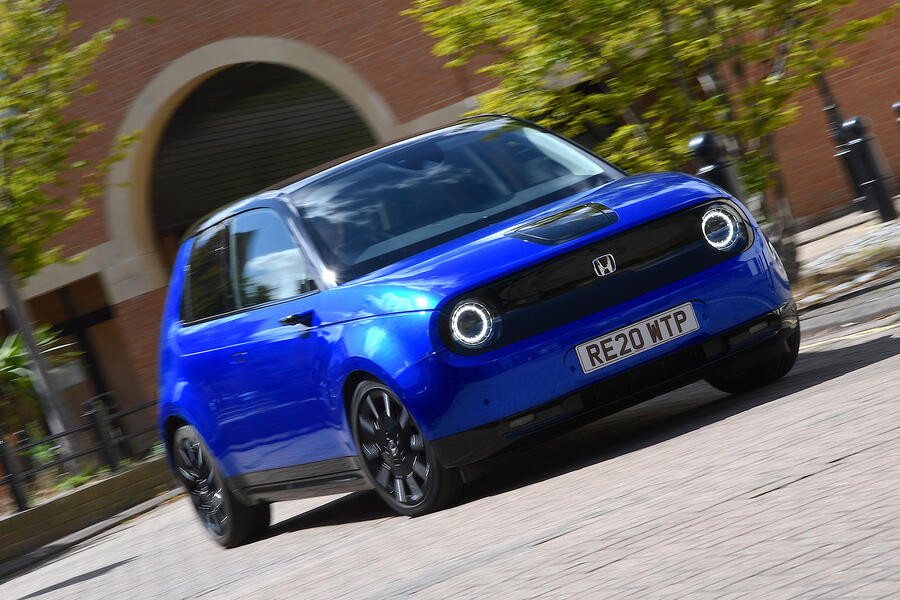
The cute and quirky E is hobbled by a real-world range that limits it to about 100 miles (officially 136 miles), but as a nippy and nimble suburban runaround, it has bags of appeal. For starters, it looks great, oozing retro appeal, while its interior is beautifully finished and features a surprisingly intuitive widescreen digital dashboard. With either the 134bhp or 152bhp motor, performance is brisk off the line, while its diddy dimensions and near-nine-metre turning circle give it dodgem-like agility, especially around town. It’s cramped in the back, the boot is small and it’s limited to 50kW charging, but if it fits in with your life, this Honda is a fun and characterful choice.
In terms of range for your cash, the Kona Electric takes some beating. The recently facelifted compact crossover claims 189 miles in entry-level 39kWh guise and a hugely impressive 300 miles with the larger 64kWh battery, and both figures are entirely realistic. Another highlight is the powerful and responsive electric motor, which is available with 134bhp in with the smaller lithium ion pack and 201bhp on all other models. The Kona Electric also looks distinctive and is decently roomy, plus it’s backed by a five-year manufacturer warranty. It’s capable rather than fun to drive, while interior quality isn’t up to the standard of a car that starts at around £30,000.
Hyundai Ioniq Electric
Featuring an unfashionable five-door family hatchback body, the Ioniq Electric is often overlooked by customers clamouring for crossovers. Costing a similar amount to the entry-level Kona Electric, it uses the same 134bhp motor and 39kWh battery, but superior aerodynamics allow it to eke out a slightly longer (193-mile) range - although it can charge at a maximum rate of only 50kW. Performance is brisk and responsible, but the ride is crashy and there’s plenty of road roar. You will also quickly come to ignore the interesting route home, because its lifeless steering and dull handling do little to lift spirits. Yet as a functional, roomy and good-value EV, it’s not without merit.
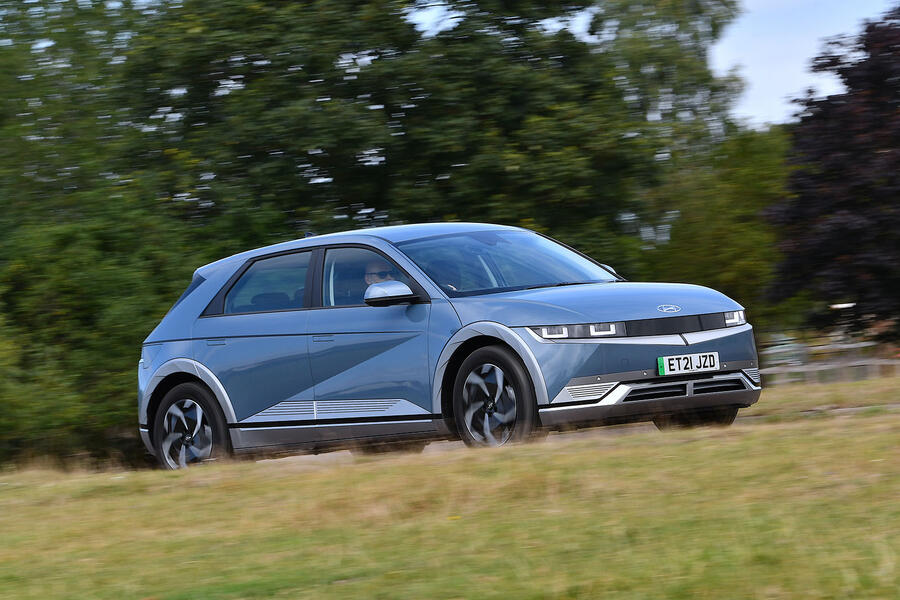
The Ioniq 5 is the car that confirms Hyundai as being at the very forefront of the EV revolution. Not only does the boldly styled five-door crossover look like nothing else on the road, it also features an interior that’s equally distinctive and uses the packaging advantages of an electric drivetrain to create a bright, airy and roomy atmosphere. Under the skin, it has 800V electrical architecture (like the Audi E-tron GT and Porsche Taycan) for the very fastest charging, plus there’s a choice of a 58kWh or 73kWh battery pack. The former gets a 168bhp motor, while the latter comes with either 201bhp (RWD) or 300bhp (4WD). Whatever you choose, the Ioniq 5 is surprisingly agile and fun to drive, making it one of our favourite EVs.
One of the first EVs from a 'legacy manufacturer', the I-Pace also proved to be one of the best. Featuring a 395bhp twin-motor, four-wheel-drive set-up, the battery-powered Jaguar isn’t short of poke, but it’s the agile and engaging handling that really stands out, making this an EV that’s fun to drive. It looks distinctive, too, with its coupé-SUV lines, while its interior is roomy and beautifully finished. Recent updates have improved its infotainment and added three-phase 11kW capability for faster home charging. Its 295-mile range remains impressive, while on a public rapid-charger, the I-Pace can accept a rate of 100kW, meaning it can gain 78 miles' worth of energy in just 15 minutes.
Quirky and capable, the third-generation Soul is sold exclusively as an EV in the UK and Europe. Using the most powerful motor-and-battery combination from the closely related Hyundai Kona Electric, it delivers an impressive range of 280 miles. The 201bhp motor serves up surprisingly brisk performance, while the quick steering and compact dimensions result in accurate and agile handling. The ride is a little firm and the boxy looks won’t be to all tastes, but as a cost-effective, roomy and well-equipped family runaround, the 64kWh Soul EV has plenty going for it. And, of course, it’s backed by Kia's market-leading seven-year warranty.
Given it’s been such a big hit for Kia, you’d think it would have played it safe with the all-new second generation Niro. Yet while the original was effective but a little blend, its replacement is packed with similarly distinctive styling cues as the Sportage SUV and rakish EV6. Under the skin there’s a larger platform that delivers more space for people and luggage, while the interior has been given a premium makeover. The 201bhp electric motor remains, but its been tuned for smoother delivery, while the 64kWh (the old car’s entry-level 3kWh pack has been dropped for now) battery can carry the Kia a claimed 286 miles. It’s still not particularly exciting to drive, but it feels more grown-up, composed and refined, making it top choice if you simply want sensible set of family EV wheels that’s decent value.
Perhaps one of the most eagerly anticipated mainstream electric cars yet, the EV6 hasn’t disappointed. While it shares its underpinning with the impressive Ioniq 5 from Hyundai, the Kia is intended as a sportier proposition, which is reflected in its higher power outputs of 226bhp for the RWD model and 321bhp for the 4WD, while the only battery option is the larger 73kWh unit. Its interior is cosier and more compact, but it handles with greater precision and control, while its more slippery coupé-style body delivers an even greater (328-mile) range. The best news is that Porsche Taycan-rivalling (yes, really!) 577bhp GT model is on the way.
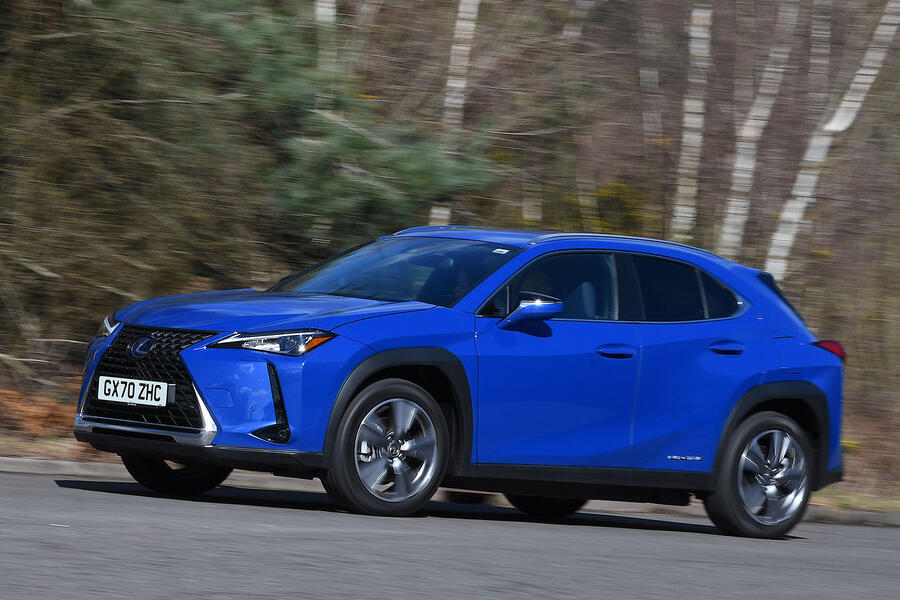
Lexus has made no bones about its commitment to hybrid power, meaning its first full EV is a bit of a half-hearted effort. A fully electric version of the angular UX crossover, it falls short of its similarly priced premium rivals in almost all areas. Its 201bhp motor is short on poke, its 196-mile range falls about 100 miles short of most and its maximum rapid-charging rate of 50kW is disappointing in an increasingly 350kW world. It;s fairly lacklustre to drive, too, with average performance and lacklustre handling. Still, it rides well, looks distinctive and is beautifully built.
There’s lots to like about Mazda’s first stab at an EV, not least its crisp handling, which has become a welcome trademark of the Japanese brand. The MX-30 looks good, too, in a quirky SUV sort of way, while details such as the rear suicide doors are nice nod to the old RX-8 sports coupé. Engineers were keen to save weight, which is good from a dynamic point of view but less so for range; the MX-30's compact 35.5kW battery results in a paltry range of 134 miles. You’re also only able to charge at a maximum of 50kW, although that small battery means an 80% range will take just 36 minutes. Characterful and good to drive it may be, but the MX-30 feels like a missed opportunity.
This is the entry point to Mercedes EV ownership, although that still means a base price of at least £40,000. Essentially an electrified GLA compact crossover, the EQA is currently only available in front-wheel drive 250 guise at the moment, which means a modest 187bhp but a respectable range of 263 miles, plus the ability to charge at up to 100kW. It looks smart enough and its interior has a premium feel that mainstream rivals can’t match. Yet it’s also cramped compared to rivals, while its firm ride and uninspiring handling make it less practical and satisfying choice than rival models such as the Hyundai Ioniq 5 and Volkswagen ID 4.
As its name suggests, this is the all-electric versions of Mercedes’s GLB SUV, which with its relatively modest dimensions and seven-seat layout has carved out it’s own niche in the upmarket compact SUV class. Having been designed from the outset to house a big battery and electric motors (one at the front and another at the back for four-wheel drive), the EQB has managed to retain all three rows of seats, giving it something of USP. In other respects it’s merely average, with the 350 4MATIC delivering a so-so range of 257 miles and a maximum charging rate of 100kW. Still, the interior is classy and it’s a doddle to drive, if far from invigorating. It’s not cheap, but if you want a compact seven-seat EV SUV it’s the only game in town.
Mercedes has hit the ground running with its first electric car, the EQC proving more than a match for rivals such as the Audi E-tron and Jaguar I-Pace. The large SUV looks fairly conventional inside and out, but it has plenty of presence and its roomy interior is sumptuously finished. Featuring front- and rear-mounted motors, the 402bhp EQC can hum from 0-62mph in just 5.1sec and squeeze 255 miles out of a full charge. Standard air suspension combines a cushioned ride with handling precision, while 100kW charging capability means it can take 40 minutes for the battery to reach 80% capacity.
Essentially a little brother to the EQS (think of the relationship of E-Class to S-Class), the EQE is Mercedes’ all-electric executive saloon. For all its sleek aerodynamic sculpture, the four-door saloon actually looks a little bland, although inside it’s well up to the brand’s standards for lavish luxury, top notch quality and cutting edge tech. Sitting on a shortened version of the EVA2 architecture that underpins the EQS, the smaller car serves-up sybaritic comfort and refinement, especially on the optional air suspension - although rear headroom is tight. Currently, only the 288bhp 350+ model is available in the UK, but the rear-mounted motor delivers strong performance, while the handling is surprisingly nimble with good grip and body control. There’s a 90kWh battery beneath the floor, which claims and impressive 394 miles on a charge.
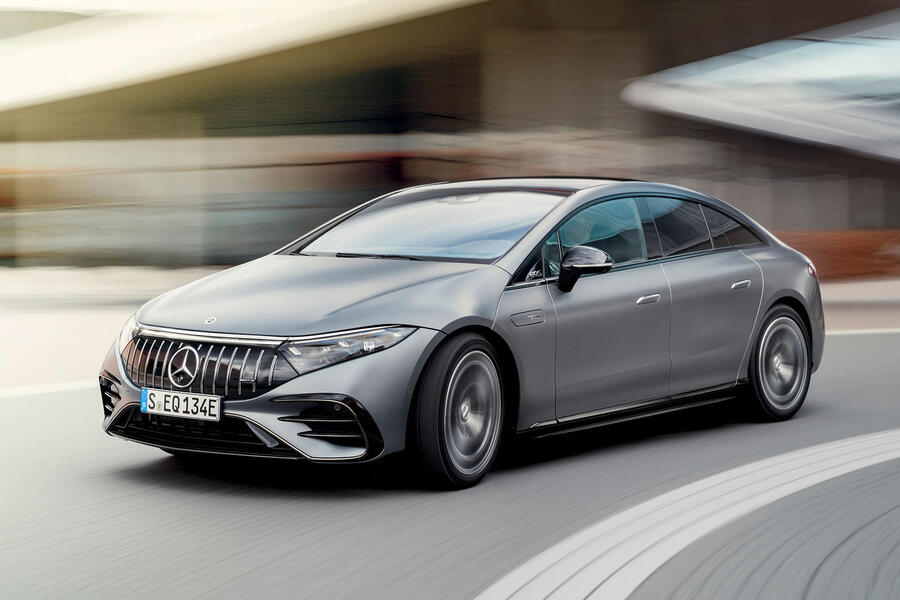
The EQS isn’t exactly an electric S-Class, but it fulfills a similar role as showcase for Mercedes' latest technology. Featuring a bespoke platform, it’s a sleeker and more stylish affair than the firm’s familiar ICE limousine, plus it handles with more poise and agility – yet it’s just as comfortable and even quieter. The luxurious cabin is dominated by a vast, 1.4-metre-wide digital display, while under the skin is a large 107.8kWh battery pack that delivers an astounding range of 485 miles in the 450+ and 420 miles in the more powerful 580. The best EV in the world? It’s certainly up there.
Based on the V-Class people carrier, the EQV makes a compelling case for taxi and private hire firms that want to carry up to six passengers in quiet and cosseting luxury. Featuring 201bhp motor, it offers adequate performance, while its 90kWh battery provides a useful 213 miles between charges. The lithium ion cells sit under the floor so cabin and boot space are unaffected (it's vast inside), while the optional air suspension serves up a plush and near-silent ride. It’s reasonably precise to drive, the commanding driving position and great visibility making it easy to place, while 100kW charging capability should mean you won’t be stationary for long.
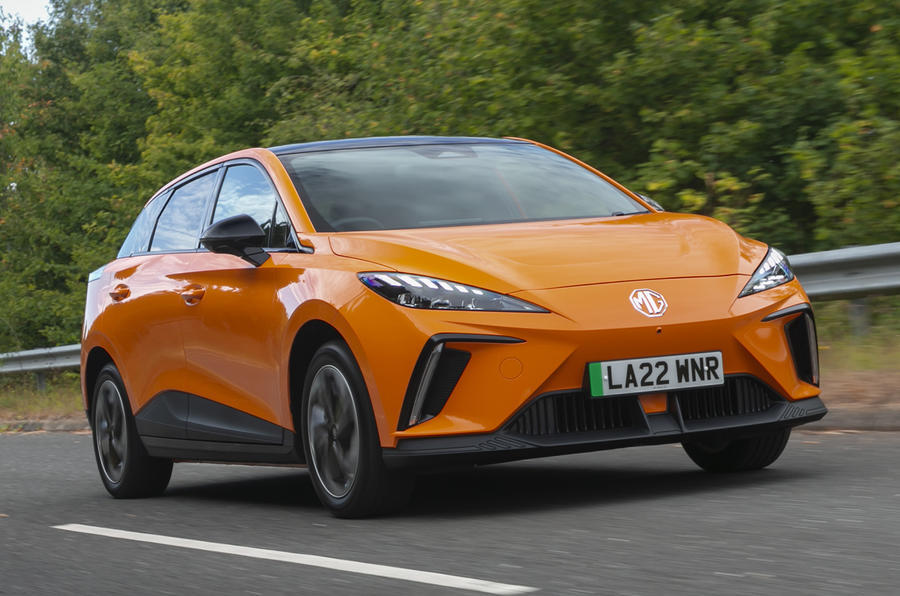
Few cars have proved as surprising in 2022 as the MG4. Almost out of nowhere, the all-electric newcomer has propelled the Chinese-owned brand from a bargain basement niche choice into a true mainstream challenger. Not only is the distinctive MG4 good to look at, it features an interior that matches rivals models such as the VW ID 3 for space, quality and kit. Yet the really remarkable part is the way the MG drives, its deft handling making it one of the most engaging and entertaining family-friendly EV models, while its 201bhp motor means its warm hatch quick. This dynamic advantage doesn't come at the expense of usability, because the larger 64kWh battery of the Long Range model promises 281 miles between charges. And the icing on the cake? Well, that's the fact that in top-of-the-range guise it £31,495, which is around £5000 less than the equivalent VW that has a shorter range.
With a dated exterior design, a relatively low-rent interior and underwhelming driving experience, the MG 5 won’t necessarily be at the top of your EV shopping list. Yet despite its flaws, the Chinese family estate car makes a decent case as practical and cost-effective entry to zero-tailpipe-emissions motoring. There’s a handy 464-litre boot and a new, larger 61.1kWh battery offers enough energy for a claimed 273 miles of motoring. With 154bhp the motor delivers very brisk acceleration, while the soft suspension delivers good comfort and quietness. And the best bit is that it costs just a little over £26,000.
Like the MG5, the electrically powered ZS sets out its stall with the value for money calling card front and centre. For just over £31,000 you get a roomy, practical and well-equipped SUV that undercuts by thousands mainstream rivals such as the Kia e-Niro. Yes the interior materials are a bit cheap and cheerful, but it looks smart enough on the outside and the 154bhp motor delivers a decent turn of speed, while its 72kWh battery claims a rather impressive 273 mile of range. Is that enough to offset imprecise handling and refinement that’s not quite as whisper-quiet as you’d expect from an EV? I guess that depends on how deep your pockets are, but for many the MG’s combination of price and range will be hard to resist.
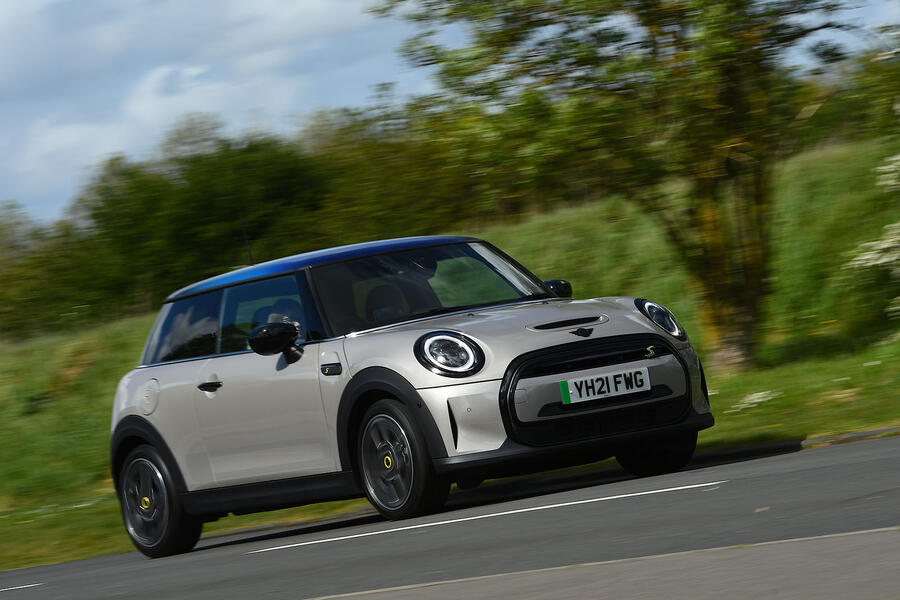
Few EV models have taken as long to reach the showroom as the Mini Electric. The British brand has been testing battery-powered versions of its three-door hatchback for more than a decade, but series-production versions didn't arrive until 2020. Luminous yellow detailing aside, it looks almost identical to the ICE Mini 3dr, plus it drives in a similar manner, thanks to its punchy 181bhp motor and agile and entertaining handling. The only downside is that you won’t be able to enjoy it for long, because the titchy 28.9kWh battery allows a range of only 144 miles, which will be closer to 100 miles in real-world use. Like the Honda E, it’s a fun runabout but will prove limited if you want to carry people and things over longer distances.
Arguably the first true family EV, the Leaf is now in its second generation and is as capable and useful as ever. Based on the original model’s platform, it’s not as cleverly packaged as the Volkswagen ID 3 or Hyundai Ioniq 5, but it’s roomy enough, easy to drive and delivers a claimed 239 miles on its 40kWh battery. It also features the brand’s e-Pedal technology, which provides enhanced regenerative braking that allows you to drive using just the throttle, as lifting off allows you to slow quickly to a stop without touching the brakes. The interior looks dated and the handling is fairly uninspiring, but it’s a practical, usable and attractively priced option.
Nissan took quite a while to deliver a follow-up to its pioneering Leaf, but the good news is that in most respects the Ariya has been worth the wait. Sitting in the increasingly popular premium SUV sector, it looks slick and features and interior that represents a big step forward for the brand in terms of design and upmarket finish. It's fairly roomy too, while the compliant ride and low noise levels make it a relaxing steer, if not a particularly exciting one. There's a choice of 63kWh or 87kWh battery sizes, with either a single or dual motor set-up. The latter offering up to 388bhp in its flagship guise, which can rattle off the 0-62mph benchmark in 5.1 seconds. However, if you're more concerned with range anxiety, then the entry-level 215bhp model with the largest battery is the best bet, promising 329 miles on a charge.
Nissan e-NV200 Combi
Very much a people carrier in the ‘van with windows’ vein, the e-NV200 Combi has a certain utilitarian appeal and in lower-specification guises represents decent value. It’s 107bhp motor delivers adequate performance and is perfectly suited to urban and suburban hops, which is no bad thing, considering its claimed range of just 124 miles. There’s room for seven inside, while the sliding rear side doors make access to the rear two rows fairly straightforward. It’s easy to drive and see out of, but the ride is a little crashy and there’s little fun to be had behind the wheel.
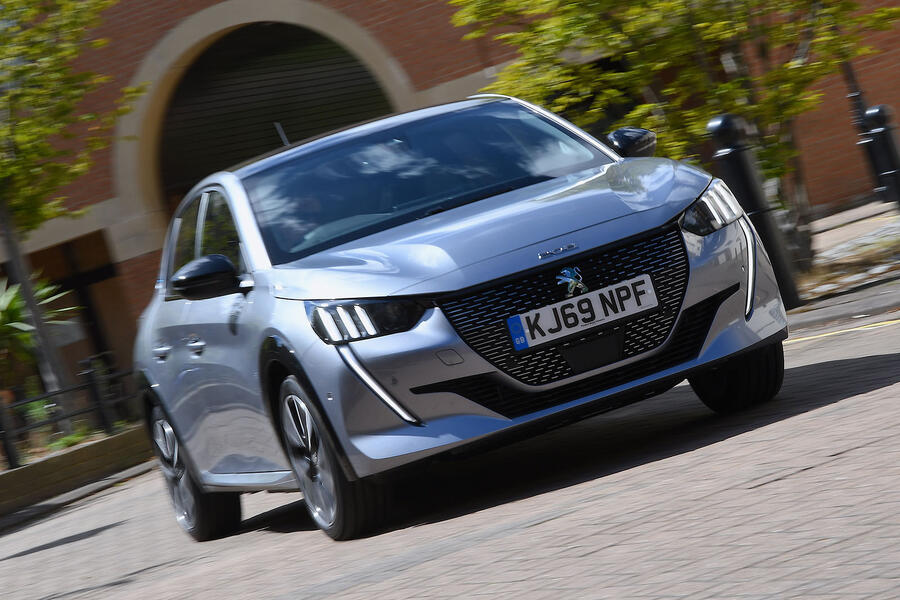
One of the best small EVs, the e-208 combines a healthy 217-mile range with grown-up driving dynamics and a dash of style. Conceived from the outset to house an electrified drivetrain, the Peugeot remains as impressively roomy as the standard ICE car, with which it shares its classy interior finish and neat 3D dials. The 134bhp motor delivers eager performance and there’s a 100kW rapid-charging option for its 50kWh battery - a rarity at this end of the market. It rides well and offers strong refinement, plus it handles neatly even if it gets a bit scrappy at the limit.
Essentially a high-riding, SUV-flavoured version of the e-208, the e-2008 is a fairly convincing battery-powered compact crossover. It looks good, for a start, while its interior is eye-catchingly styled and packs just enough space for most - its 434-litre boot is particularly useful. Under the sharp looks is the familiar 134bhp motor and 50kWh battery combo, which delivers brisk acceleration off the line and a respectable 206 miles between charges (like the e-208, 100kW rapid charging is an option). Precise handling and a refined ride make it an easy-going companion on the road.
e-Rifter
Peugeot’s brilliantly rational Rifter is now only available in all-electric guise, sharing the same 134bhp motor as the e-208. The extra weight of the boxy MPV’s body means that performance is similar to the old petrol-engined versions, although it feels faster around town. It’s also hampered by a relatively small 50kWh battery, meaning it covers just 172 miles on a charge (166 miles for the longer seven-seater). Still, the interior is as vast as ever with endless useful storage cubbies and a vast boot, while its soft ride, excellent visibility and torquey motor makes it a doddle to drive.
e-Traveller
Like the Mercedes EQV, the e-Traveller is better suited to private-hire firms looking for a zero-emissions airport shuttle than it is to families after a large MPV. It can seat up to eight in its cavernous van-based body, but by sharing the Rifter’s 50kWh battery, it’s limited to a claimed 148 miles between charges, meaning it's better suited to short hops than long hauls. This is backed up by the familiar 136bhp motor that’s mated to a single-speed transmission geared for low-down response (top speed is just 81mph). It’s easy to drive and rides well, but the e-Traveller’s commercial roots mean it doesn’t feel as sophisticated as some.
Volvo’s all-electric start-up has delivered a strong first effort in the 2, a classy hatchback that combines coupé and crossover styling cues to surprisingly good effect. Better still, it’s good to drive, with satisfyingly agile handling and a supple ride, assuming you steer clear of the expensive Performance Pack and its manually adjustable Öhlins dampers. The twin-motor set-up delivers a scorching 0-62mph pace and all-wheel drive, while the 78kWh battery offers 292 miles of range and 150kW charging. A less costly and powerful single-motor model has just arrived, promising 336 miles between charges in Long Range guise. All versions play the sustainability card, with vegan interiors available if you so desire.
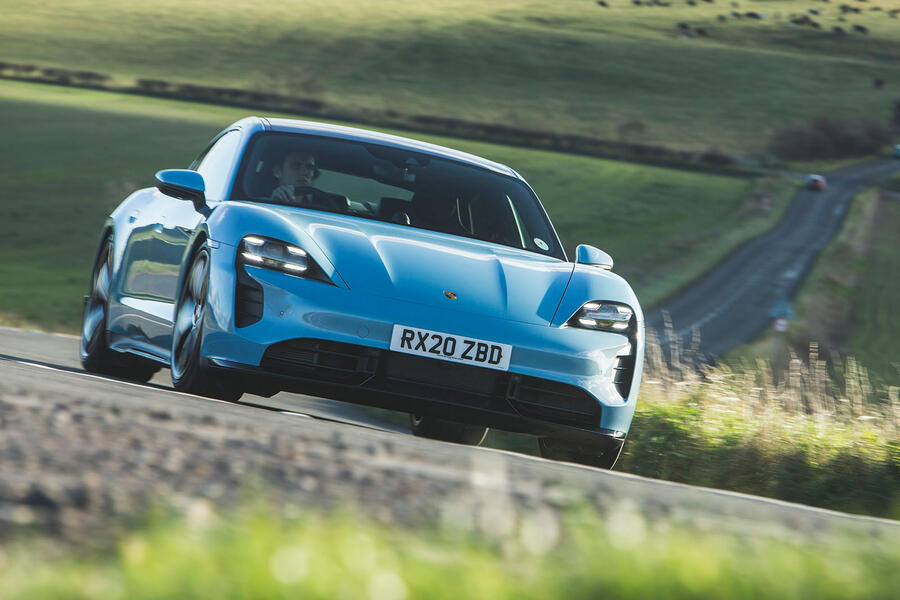
We knew the automotive world was serious about EVs when Porsche unleashed the Taycan. Built on a bespoke platform, the all-electric saloon delivers new standards of performance and precision, being almost as exciting and invigorating to drive as the brand’s ICE models. The 751bhp Turbo S models are shatteringly fast, but there are no slouches in the line-up, while handling is engaging, adjustable and agile. Interior is beautifully finished and supremely comfortable, while 800V architecture allows 270kW charging while the range is as much as 318 miles. Rugged Sport Turismo adds a bigger boot, while the Cross Turismo includes the extra carrying capacity plus some tough plastic body cladding and a height-adjustable ride for an SUV vibe.
Few EVs offer such a stripped-out, back-to-basics experience as the Twizy: the Citroën Ami is positively profligate by comparison. Essentially a four-wheeled scooter, the Renault has a roof but no doors to speak of, while the two occupants (driver at the front and passenger in a rear jump seat) are perched on plastic moulded chairs. With a 62-mile range and just 17bhp, the short and narrow machine is at its best on city streets, where its rear-wheel-drive handling and quick steering make it surprisingly fun to drive. It’s cheap to buy but a rock-hard ride and exposure to the elements mean this is one for dedicated fans only.
Europe’s best-selling EV makes lots of sense on paper, not least because it's affordable to buy and run, has a good range and is usefully practical. A recent facelift has sharpened the supermini’s looks and improved the interior quality, including the introduction of a slicker infotainment system, but it’s the addition of a 52kWh battery that’s the biggest improvement, delivering a 245 mile range. The 134bhp electric motor delivers eager acceleration, although the regenerative braking mode is weak. It’s easy to drive, with direct steering and decent grip, but there’s little fun to be had and the ride is a touch firm. However, as a great value and practical small family car it’s got a lot going for it, even though it’s now only available in GT-Line + trim.
Given its head start in the race to electrification, it’s taken a long time for Renault to cash-in on its success with other EV models. However, early impressions suggest that the distinctive Megane E-Tech has been worth the weight, the VW ID3-rivalling hatchback providing a welcome dose of design flair and dynamic sparkle to the all-electric family car class. Available with a choice of 168bhp and 215bhp motors driving the front wheels, the Renault is brisk enough, while the 40kWh and 60kWh battery options deliver ranges of 186 and 292 miles respectively. Inside, the bold design continues, while classy and eco-friendly materials create an upmarket vibe. Crucially, the Megane handles with fluency and delivers a surprisingly supple ride, making it more satisifying to steer than most. Prices are yet to be confirmed, but should start at around £30,000.
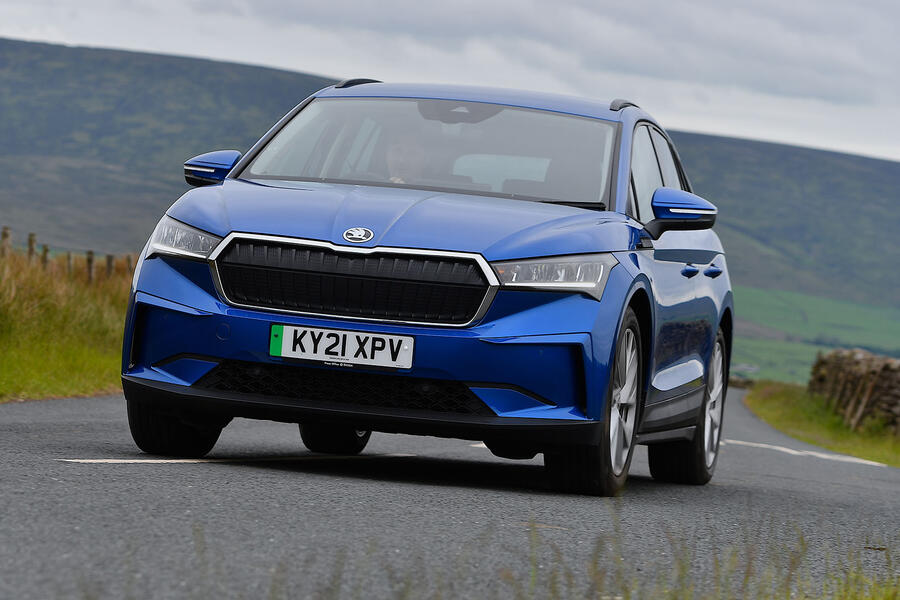
With the demise of the Citigo iV, the Enyaq iV is Skoda’s only all-electric option. Still, it’s one of the better family-sized EVs you can buy, blending space and practicality with an impressive range and assured driving dynamics. Based on the same rear-engined MEB platform as the VW ID4 and Audi Q4, the Skoda is even roomier and packs an interior ambience that’s every bit as upmarket as that of its close relatives. Supply issues and low demand means the 62kWh battery has been dropped, leaving just the 82kWh option, which packs a claimed range of 331 miles. A 261bhp twin-motor all-wheel drive version is also available, boasting a 6.7 seconds 0-62mph time. Rapid 125kW charging is optional, but 50kW is standard, while a rakish Enyaq Coupe iV is just around the corner and will include a hot 295bhp vRS flagship.
Fortwo and Forfour
Quirky and compact, Smart city cars have been largely forgotten over the past few years. Now only available as EVs, the two-seater Fortwo and four-seater (you’ve guessed it) Forfour remain a niche choice for owners who rarely see themselves going beyond the city limits. Why? Well, with a tiny, 17.6kWh battery, the furthest you’ll go on a charge is a claimed 81 miles. Still, it’s agile and wieldy around town, and the Smart also offers fairly quick low-speed acceleration from its rear-mounted 81bhp motor. There are endless trim choices and customisation options, too, making it the ideal four-wheeled fashion accessory.
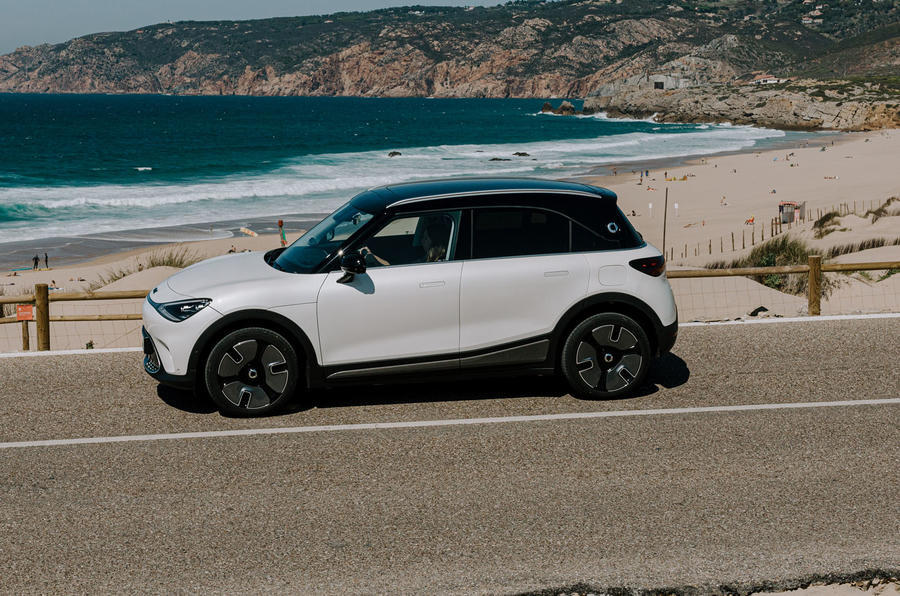
It's a another new start for Smart, which is reinventing itself as an upmarket brand. It's still under the ownership of Mercedes, but the new #1 (and you do call it the 'hastag one'. Sorry) has been developed in partnership with Chinese brand Geely, which owns Volvo and Polestar. It's a bigger car than the ForTwo and ForFour (which stay on sale for a little while longer), and is similar in size to a Hyundai Kona. The entry-level car gets a rear-mounted 268bhp motor, while the high performance Brabus model packs a brain-scrambling 422bhp. Both versions are quick on the road, yet while the handling is precise and predictable there's precious little fun to be had. All have a 66kWh battery that delivers a range of up to 273 miles, while rapid charging up to 150kW is possible.
Ssangyong
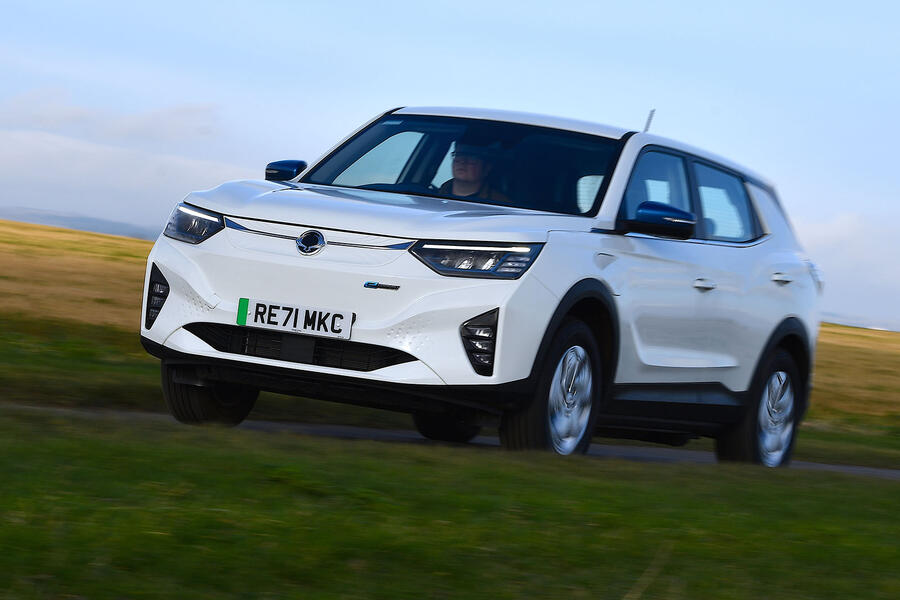
Ssangyong has stuck to its value-for-money roots for its first EV, with the result that few rivals will give you more kWh for your cash. Based on the slightly ungainly ICE Korando, the new e-Motion combines a punchy 188bhp electric motor and decently-sized 61.5kWh battery to deliver a respectable claimed range of 211 miles. Better still, it does all this for a starting price of just £30,495, which is around the same price as a mid-spec Peugeot e-208. Yet you don’t get supermini space for that price, with the Ssangyong serving up a roomy interior that’s bursting with kit, plus a generous 551-litre boot that rivals the Skoda Enyaq for carrying capacity. Of course you don’t get something for nothing and the e-Motion’s budget roots are obvious in its lifeless handling and fairly lead-footed ride, but if you’re looking for spacious, well-equipped, easy-to-live-with and no no nonsense family SUV for not much money it makes a compelling case for itself.
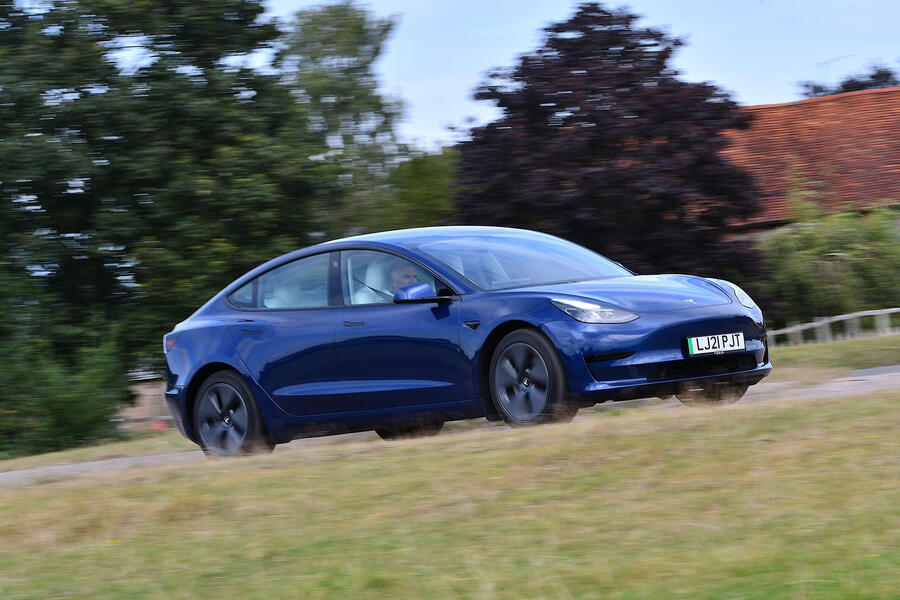
Britain’s top selling EV is the car that forced legacy car manufacturers to sit up and take notice. While Tesla’s Model S and X were niche products bought by early adopting technophiles, the company’s current entry-level machine has found a much broader customer base. It’s not hard to see why either. Even the standard rear-wheel drive car will zip to 60mph in under six seconds, while the four-wheel drive Performance takes just 3.1 seconds. All versions handle with agility and precision. The Long Range can crack 374 miles between charges, while the firm’s public Supercharger network makes it quick and easy to top-up on the run. It’s also spacious, well-equipped and better built than previous Tesla efforts.
Tesla’s first full production car after the Lotus Elise-based Roadster, the Porsche Panamera-chasing Model S got the jump on established automotive brands. Continual updates have kept it competitive statistically, with up to 401 miles on a single charge for the Long Range, while the triple-motor Plaid delivers nearly 1000bhp and a sub-two-second 0-60mph time. A huge infotainment screen and an optional seven-seat layout help it stand out, but its handling is still wooden and its fit and finish still feels a little low-rent compared with premium rivals. As with other Teslas, the Supercharger network is a big selling point, offering easy, on-the-fly charging.
With its distinctive gullwing rear doors, the Model X SUV has no trouble standing out from the crowd. Using much the same architecture as the Model S, the high-riding seven-seater combines blistering straight-line pace with class-leading claimed range, with up to 348 miles possible between charges. There’s also the 986bhp Plaid model, plus the inclusion of Tesla’s controversial Autopilot autonomous driving technology. It still lacks the solidity of the Model 3, while the handling remains fairly lifeless despite numerous suspension updates.
It’s taken a while to arrive, but finally the car that Tesla fans have been waiting for has hit British showrooms. Combining the (relative) affordability and range of the Model 3 with a more rugged SUV look, the Model Y should ensure the firm’s recent stormng of the UK sales charts was no flash in the pan. Offering a raised ride height, elevated driving position and even more spacious ineterior than the 3, the Y is all other respects remarkably similar to its saloon sibling. There’s the same minimalist interior with vast touchscreen as well as a driving experience that melds decent agility and composure with strong performance. All are twin motor four-wheel drive, with the Long Range promising 331 miles on a charge and 0-60mph in 4.8 seconds, while the 483bhp Performance can demolish the same performance test in 3.5 seconds but gets a shorter 319 mile range.
Toyota
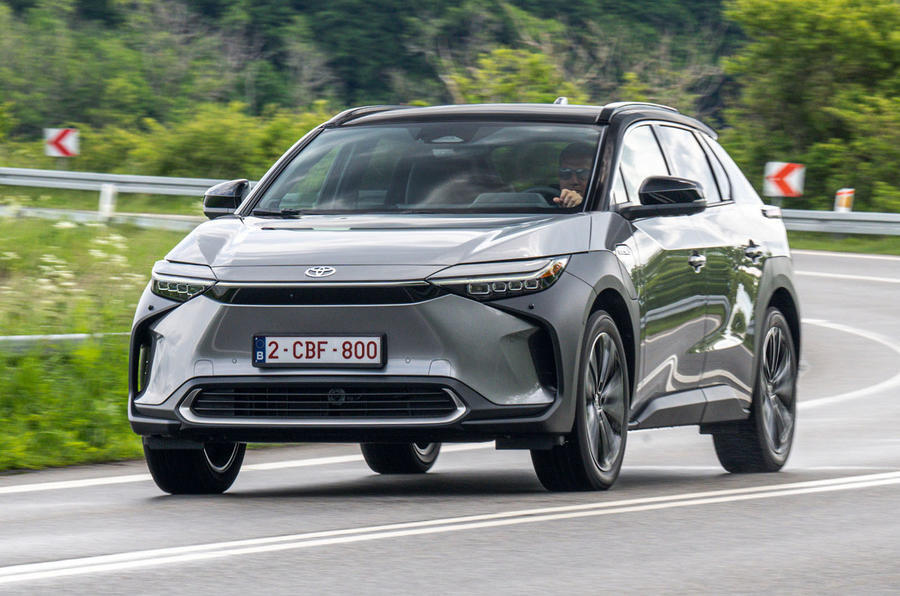
After spending quite some time being fairly vocal EV sceptics, Toyota has finally faced commercial an legislative reality and jumped on the zero emissions bandwagon. The Japanese firm is now planning a comprehensive EV model offensive, and the strangely-named bZ4X is it's first offering. A rival for models such as the VW ID 4, the Toyota is based on the firm's eTGNA platform and feautres a choice of single or double motors, all featuring a 71.4kWh battery that in the lowest powered entry-level car delivers a claimed range of 317 miles. Like its rivals, the bZ4X isn't thrilling to drive, but it handles with a slick precision, is comfortable and decently refined. The interior is also well-built, spacious and well-equipped, making it a hassle-free family runaround.
Now it's part of the Stellantis group, Vauxhall shares much of its technology and CMP architecture with other brands such as Peugeot, which explains why under the skin the Corsa-e supermini is essentially an e-208. That’s no bad thing, however, as it means the handsome hatchback gets the same zippy 134bhp motor and a 50kWh battery that’s capable of 100kW rapid charging. Its range is a little shorter at 209 miles, but it’s enough for a car that will be expected to tackle the odd long haul. Refinement is good and while the handling lacks panache, it is at least precise and vice-free. There’s also loads of kit and a wide variety of trim levels.
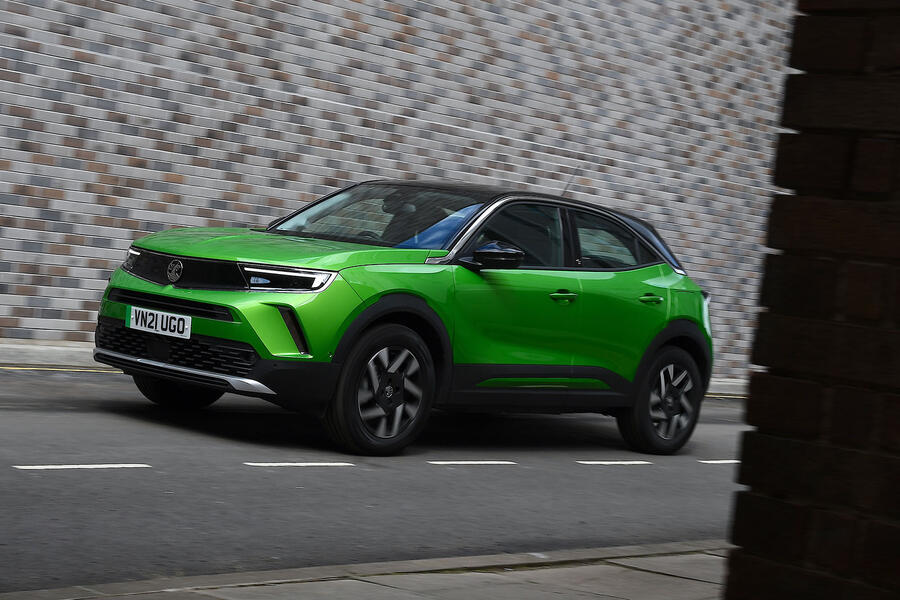
As with the Corsa, the mud-plugging tinged Mokka-e takes its hardware from another Stellantis sibling, in this case the Peugeot e-2008 compact crossover. It looks a little more distinctive than the French car, while inside its widescreen wraparound TFT screen gives the interior a premium feel. With around 1500kg to haul around the 134bhp Mokka-e doesn’t feel much faster all out than the 1.2-litre petrol, but it’s obviously quieter and quicker of the mark, while the handling is secure if lacking in sparkle. Its 310-litre boot is cramped by class standards, but it’s most hobbled by its 201 mile range, which is some way short of the similarly-sized 64kWh Hyundai Kona.
Combo-e Life
Essentially a rebadged version of Citroen’s e-Berlingo and Peugeot’s e-Rifter, the Combo-e Life is a family car that puts practicality first. Sliding rear side doors, a cavernous 597-litre boot and vast interior packed with hidden storage mean you're likely to run out of belongings before it runs out of space, plus there’s also a seven-seat XL version. Under the boxy exterior is the same 134bhp electric motor that offers just enough performance, plus a 50kWh battery that can only squeeze a claimed 174 miles between plug-ins - although 100kW rapid charging means 80 percent capacity in half an hour. A soft ride and light controls make it an easy going choice.
Vivaro-e Life
Another of Vauxhall’s badge-engineered models, the Vivaro-e Life is the brand’s largest MPV, offering up to nine seats in steel-wheeled, utilitarian Combi guise. The more luxuriously appointed Elite can only squeeze in eight occupants, but they do sit in leather-lined and climate-controlled luxury while bathing in the light of a panoramic glass roof. Regardless of version, you get the 134bhp electric motor and 50kWh battery that delivers a claimed 143 miles of range, making it fine for executive shuttle duties or as a short-haul family transporter, but less useful for long-haul holiday use. It’s easy to drive and has a smooth ride, but the diesel versions will show it a dirty pair of heels in a straight line.
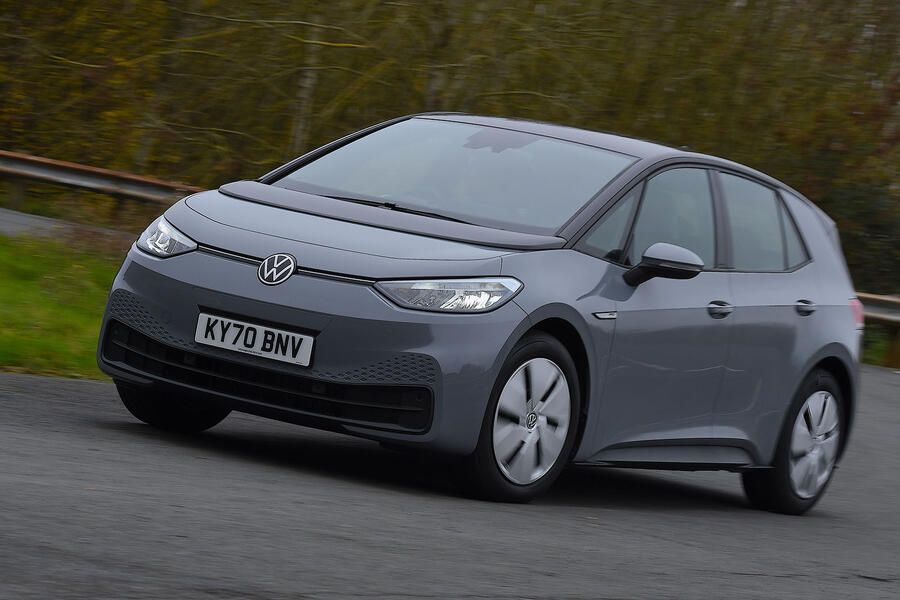
Perhaps no electric car has arrived with such a weight of expectation as the ID 3, the first bespoke EV from the manufacturer that gave us iconic family car creations such as the Beetle and Golf. In many respects it doesn’t disappoint, looking futuristic and featuring a spacious cabin that makes the most of the packaging opportunities delivered by its rear-mounted motor and battery beneath the floor. Currently, there's only a 58kWh battery option that's paired to a 201bhp motor for a maximum claimed range of 265 miles, while 120kW rapid charging means 180 miles can be added in half and hour. It’s not exciting to drive, but the polished dynamics and comfortable ride make it easy to live with.
Following hot on the heels of the ID 3 was the predictably SUV-flavoured ID 4. Offering a raised ride height and even roomier interior, the big VW is a still more practical choice. Essentially a reskinned Skoda Enyaq (or Audi Q4), it’s only available with the larger, 77kWh battery, meaning a minimum claimed range of 316 miles. On the move it drives with same assurance as the ID 3, while its rear-mounted motor is available in the same states of tune. The recently launched GTX offers GTI levels of fun and has twin motors, four-wheel drive, lower suspension, plenty of red trim inserts and 295bhp.
Essentially an XC40 Recharge in a sharp suit, the C40 is the first Volvo to be offered exclusively with an EV heart. Taking the now fashionable SUV-cum-coupe route, the sleek Swede is available with a 402bhp twin motor set-up and a 78kWh battery for a very handy, WLTP-ratified 274 mile range. Despite the impressive power output, the C40 is happier wafting along motorways than waltzing down back roads, its soft suspension and hefty 2185kg kerb weight dissuading you from getting too carried away. In many ways, that makes the less expensive, 221bhp single motor versions a better bet, even if its 67kWh battery claims a less rangey 269 miles on a charge. Still, both are refined on the move and have a classy interior with the brand’s trademark Google infotainment. It’s only problem is that the XC40 is more practical and the equally closely-related Polestar 2 is more dynamic
Few firms have been as eager to end their reliance on fossil fuels as Volvo, but it’s taken a while for the Swedish firm to launch its first all-electric offering. Essentially a taller and slightly roomier version of the Polestar 2, the XC40 Recharge Twin uses the same dual motor layout that delivers 402bhp and four-wheel drive, but its bluffer SUV body means the 75kWh battery delivers a claimed 259 miles of range rather than 274. It’s softer suspension and high riding stance means it’s less capable in corners too, even if the straight-line performance is equally scorching (0-62mph in 4.7 seconds). Less costly and lower powered versions will make more sense, but like the Recharge Twin they will only be available to order online as the brand continues to look toward a digital future.

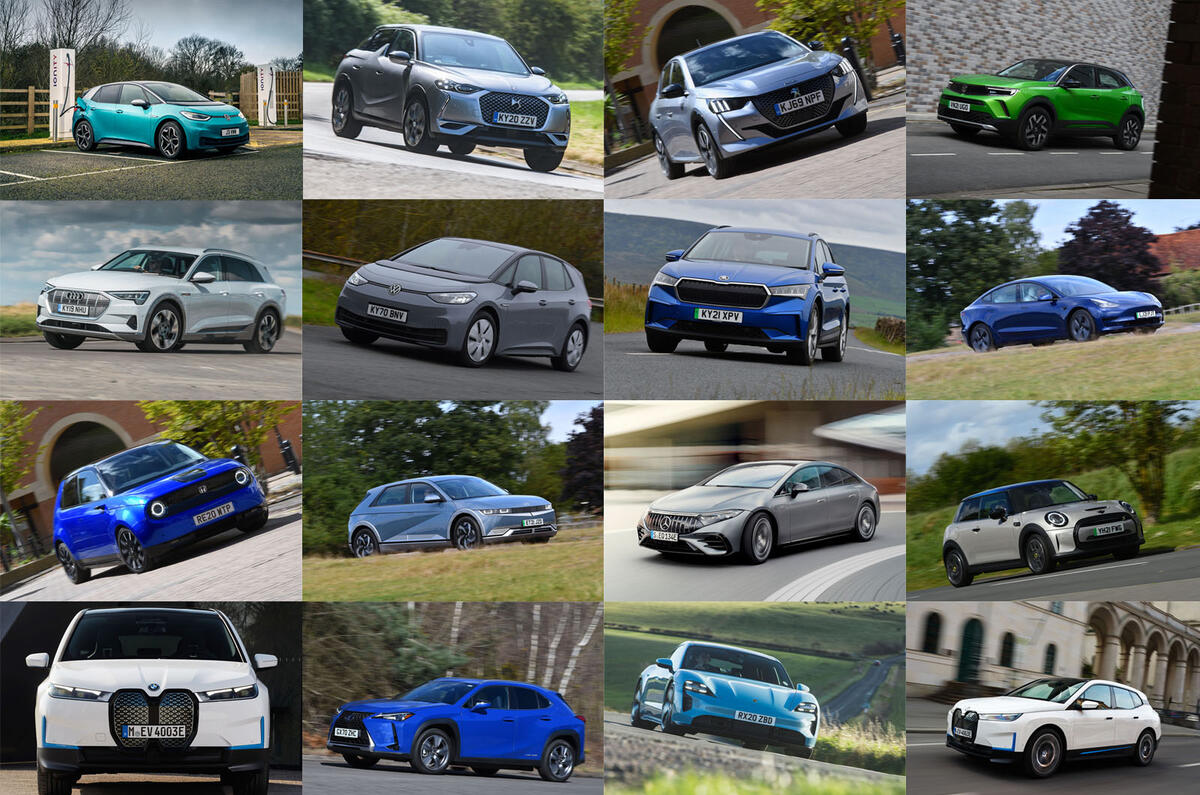




Join the debate
Add your comment
Stick with ICE. It's cheaper in every way.Just heard of a guy with a 9 year old Tesla needing a new battery. The price was £17,000, and yes that is not a misprint. Milk floats are not for real drivers
I wasn't aware you could buy the BMW iX 'today', as the heading says. I've not seen any on the road. Or maybe that's because no-one is buying the hideous looks?